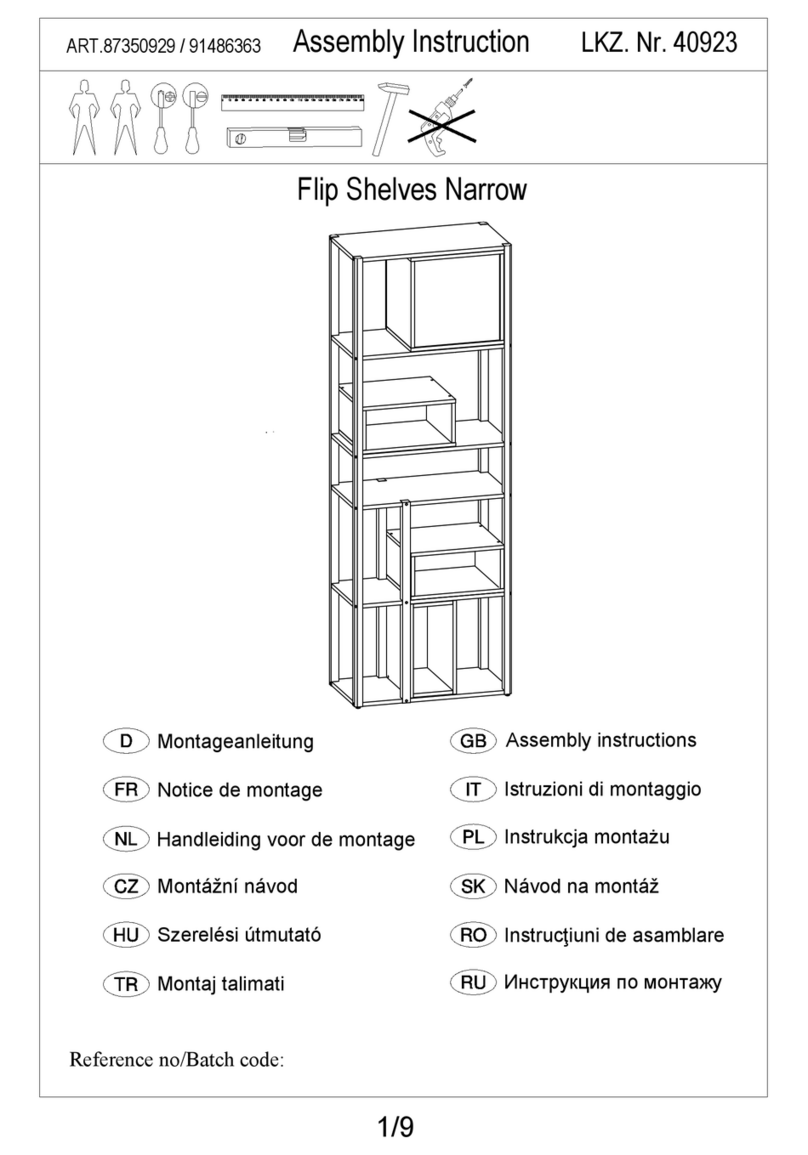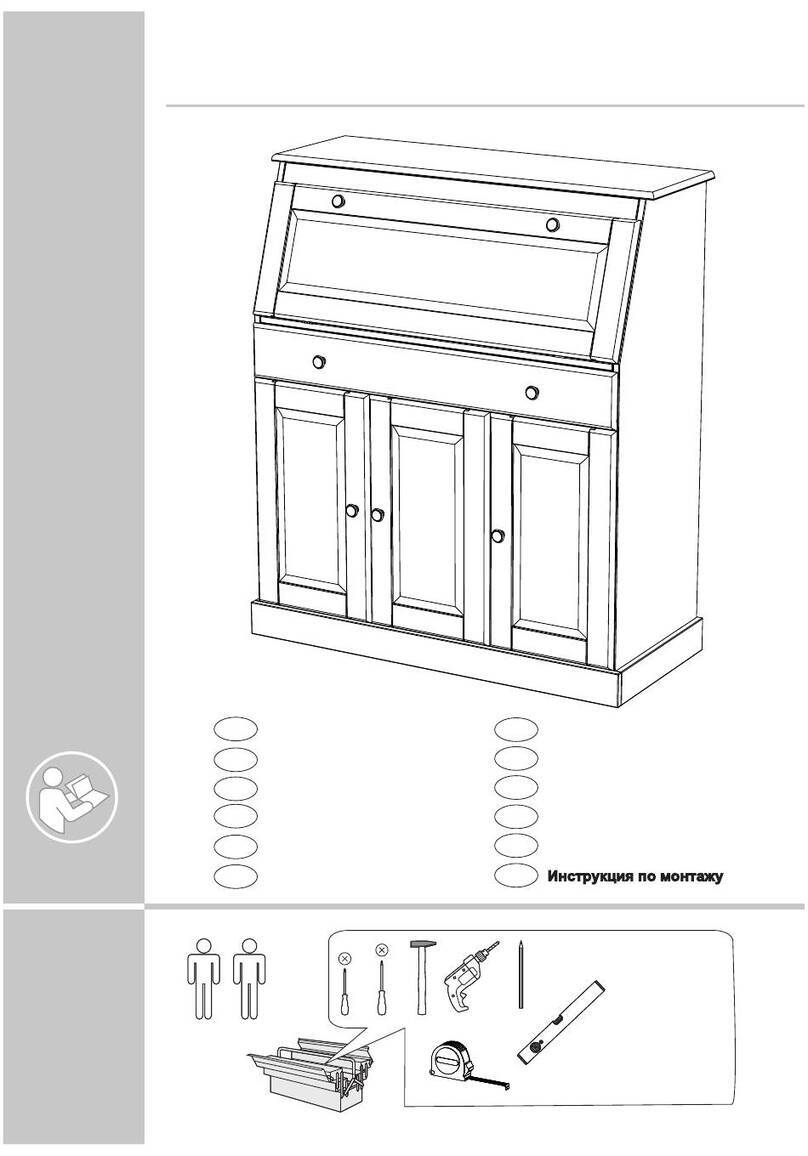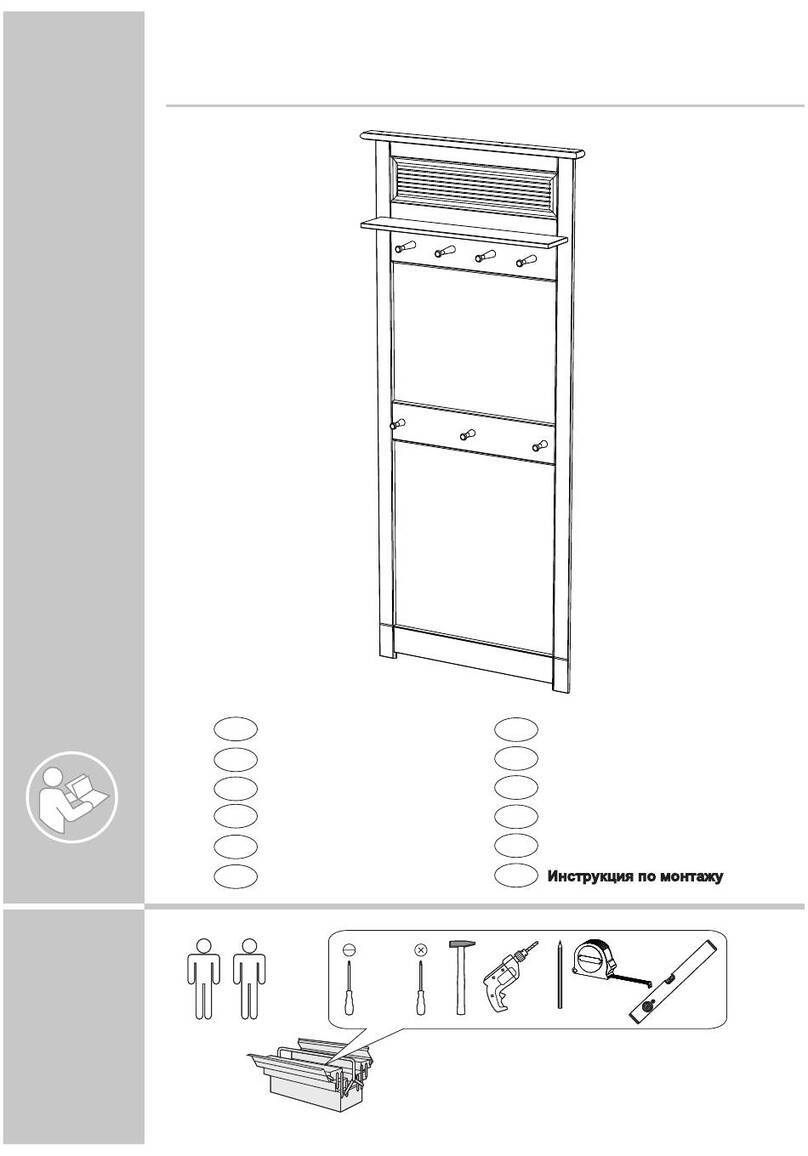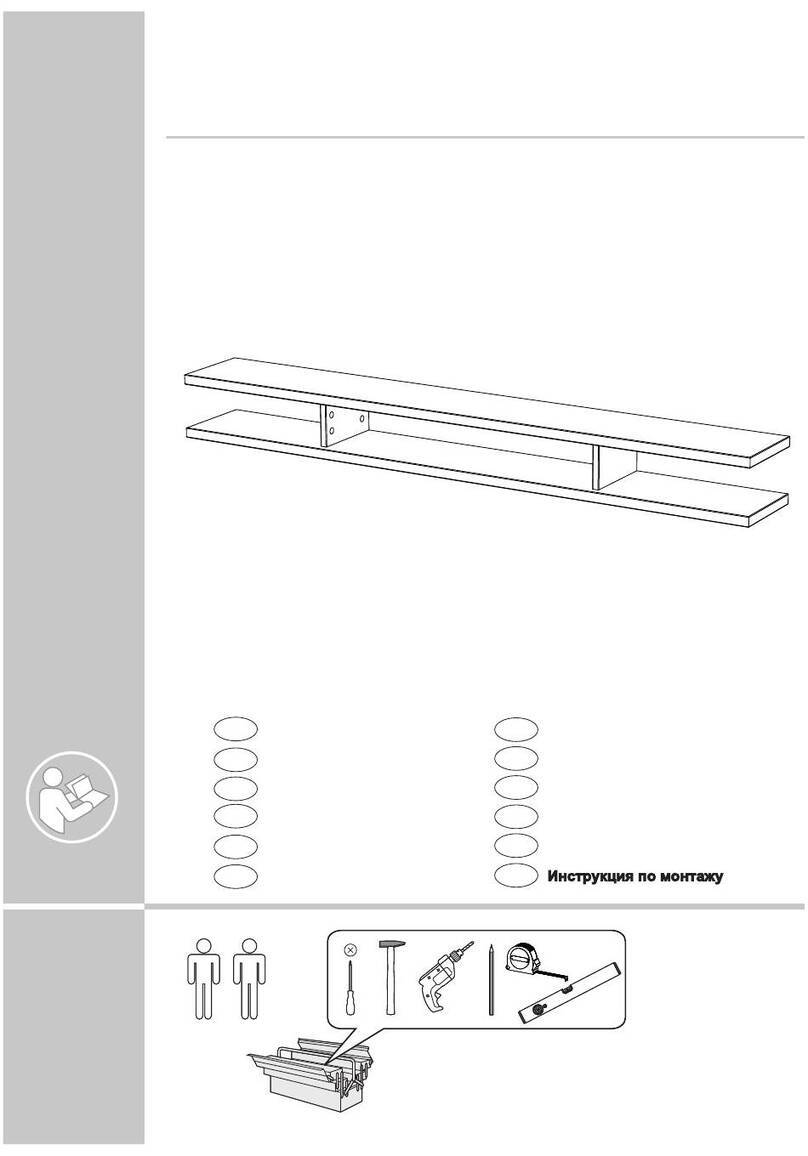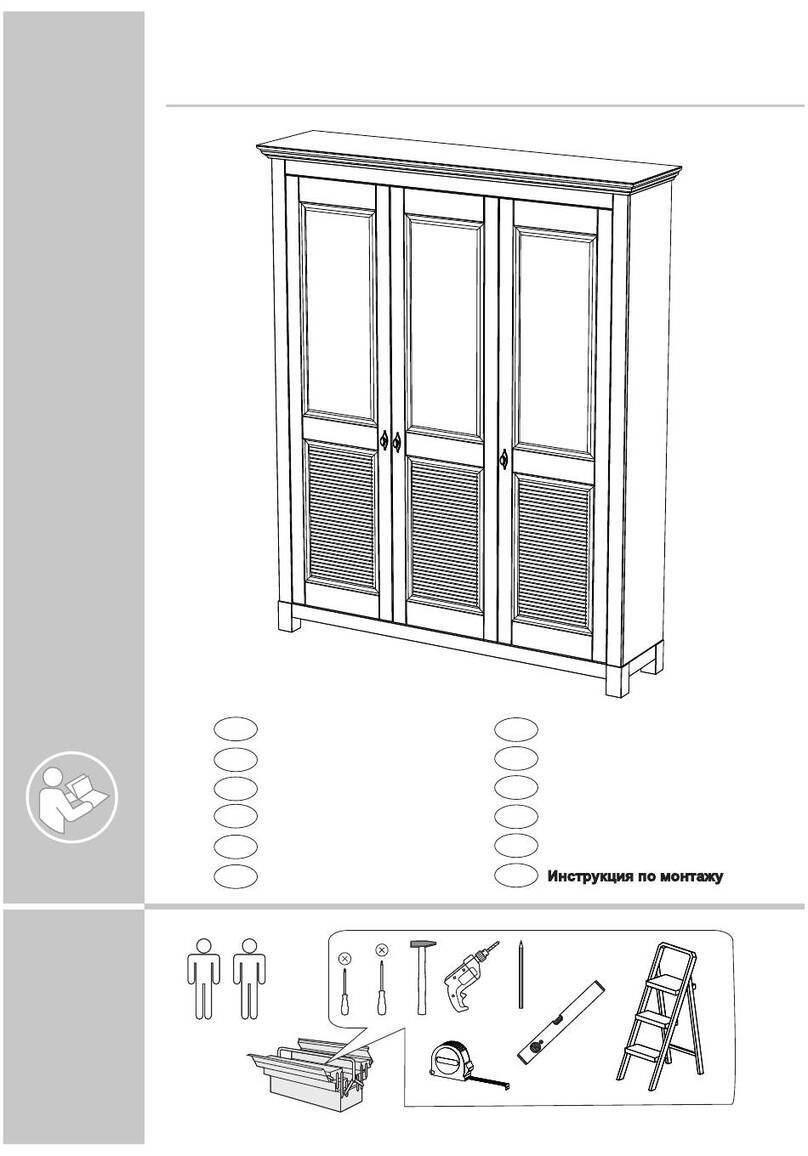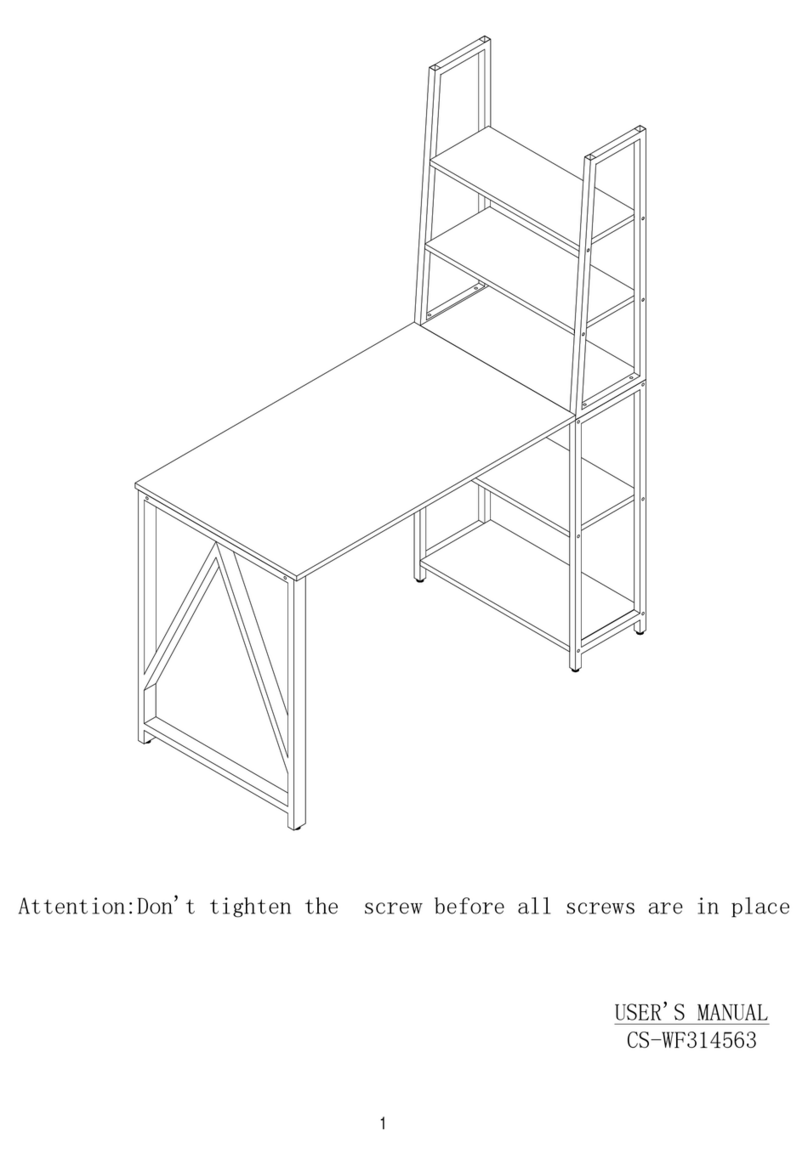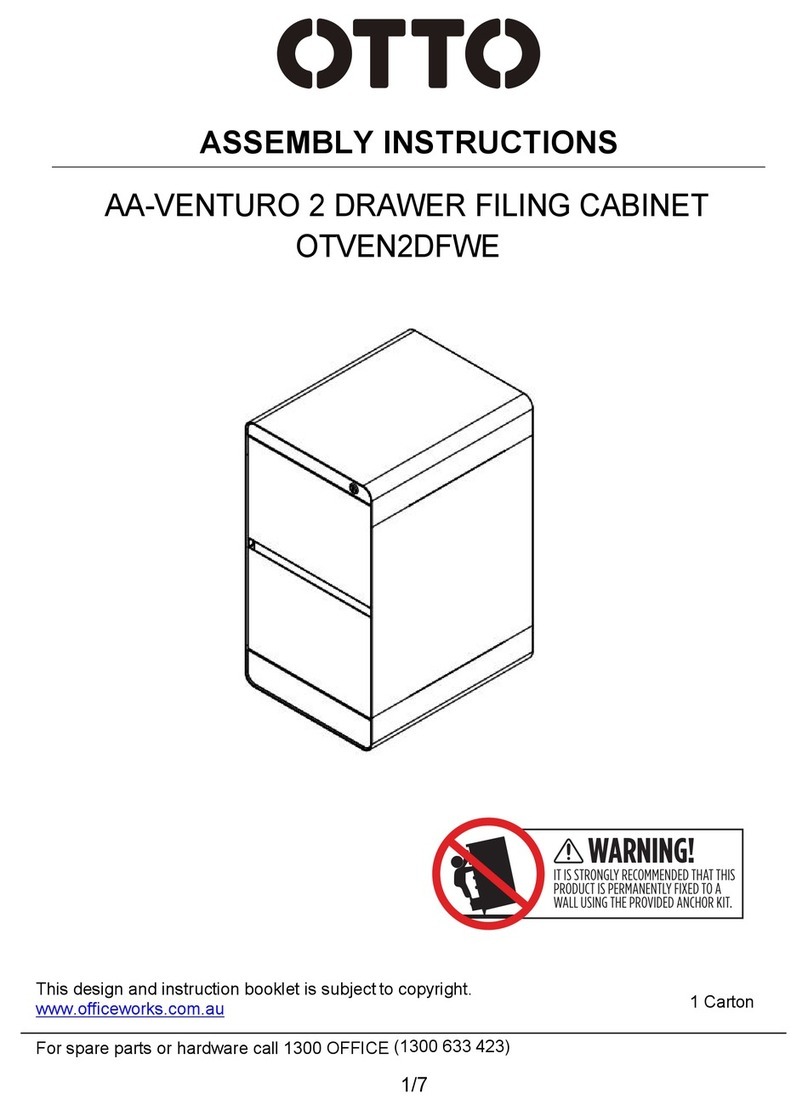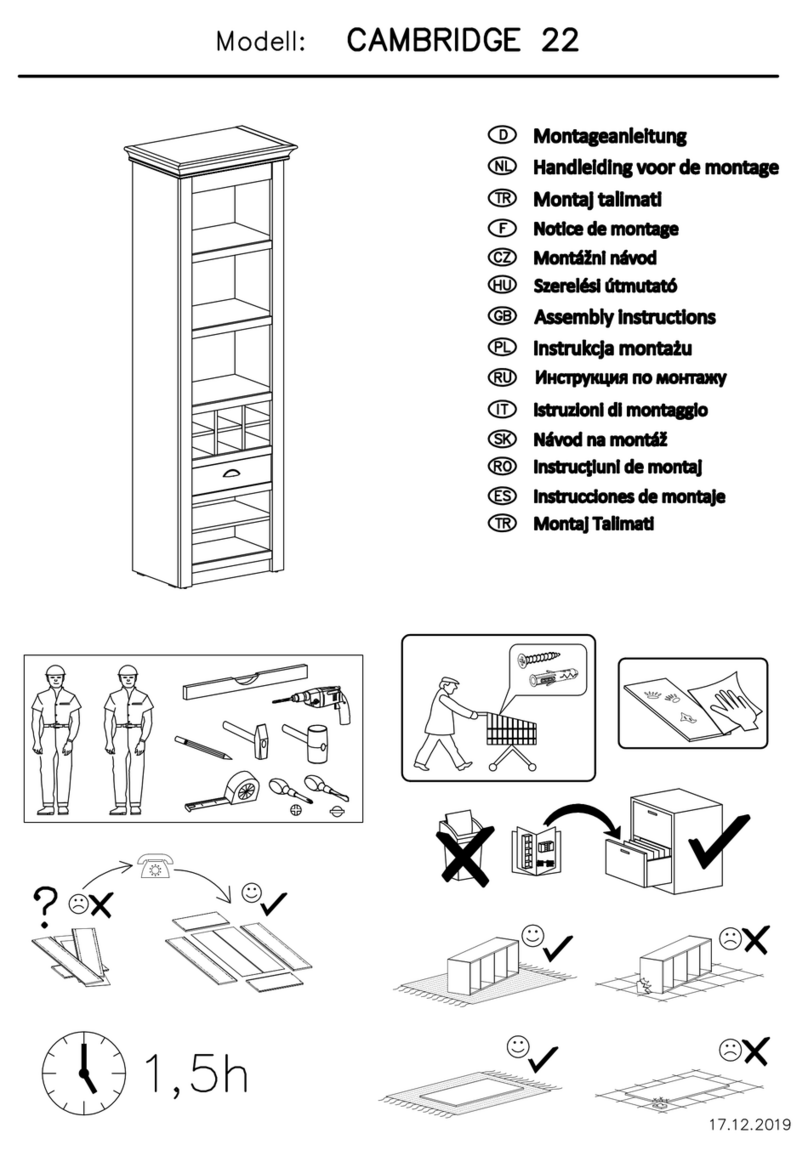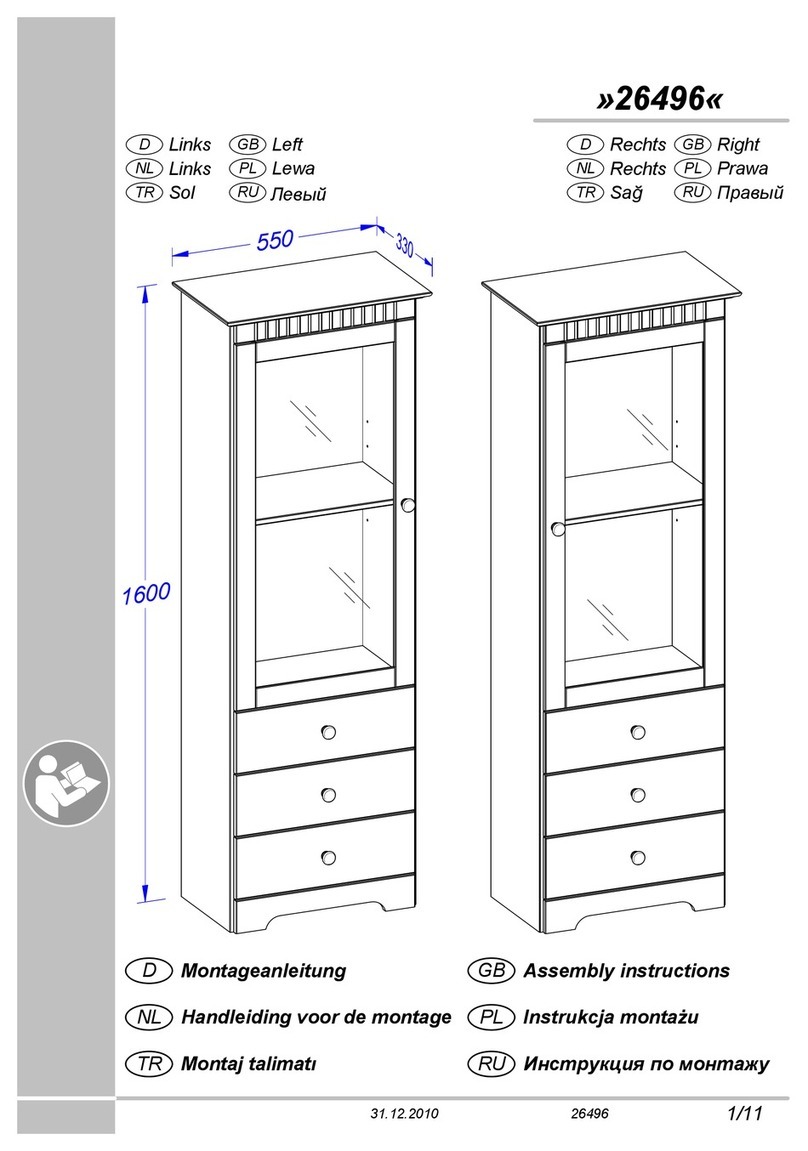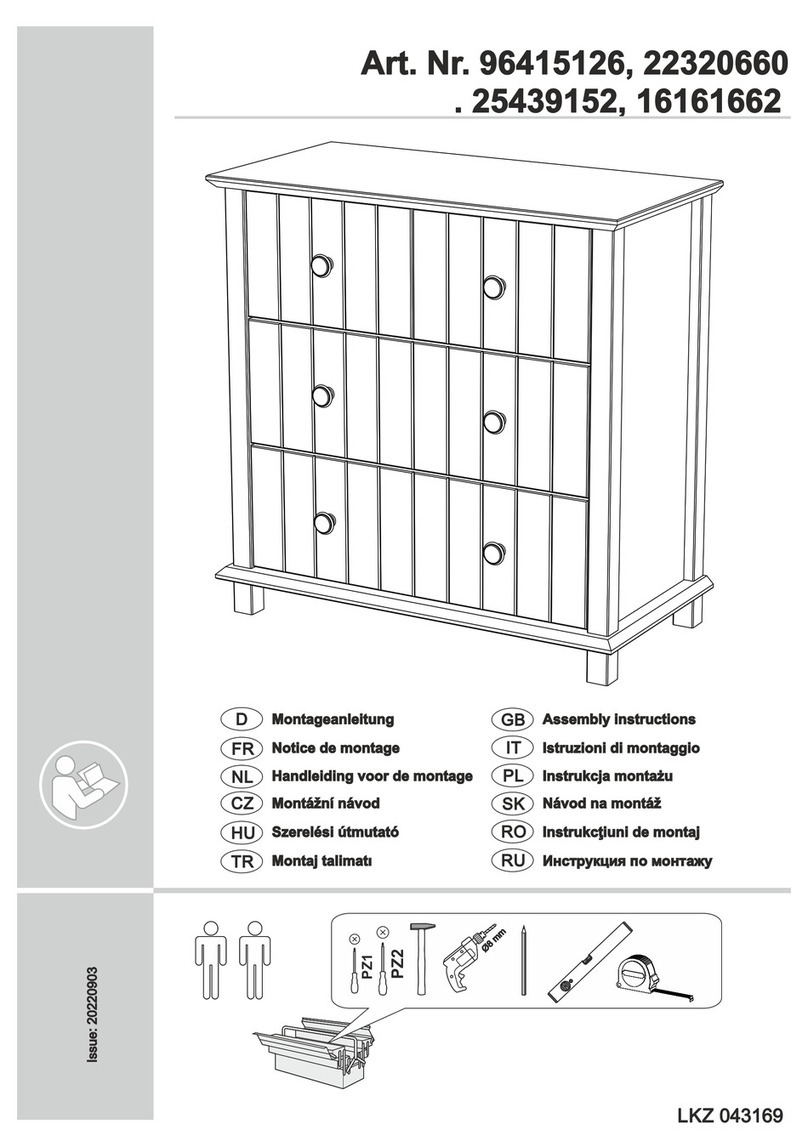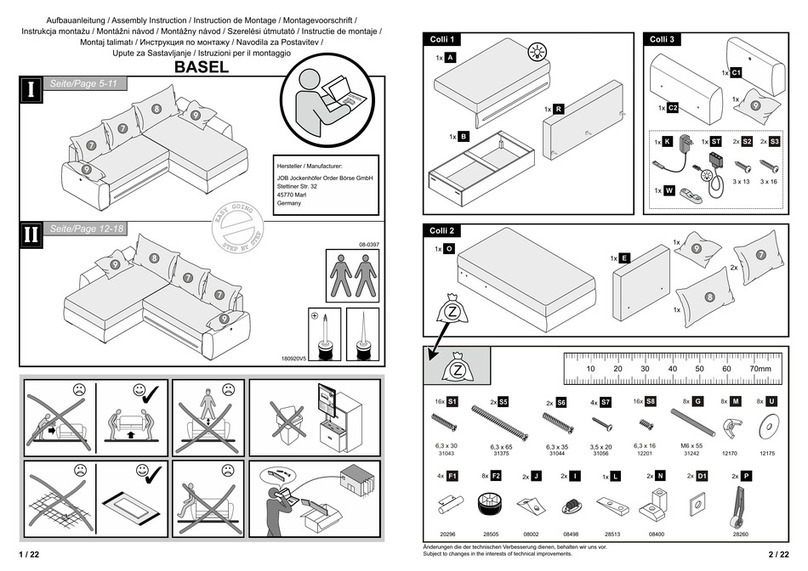
Onderhoudsinstructies voor meubelen van plaatmateriaal
Gebruik voor de reiniging van uw meubel van plaatmateriaal het best een zachte,
niet pluizige doek of een leren doek. Veeg de oppervlakten ietwat vochtig af.
In principe geldt: Gebruik zeker niet volgende reinigings- en poetsmiddelen:
•microvezeldoeken of vuilgommen. Deze bevatten vaak fijne slijpdeeltjes die
kunnen leiden tot krassen op de oppervlakken;
•scherpe chemische substanties zoals schurende poets- of oplosmid-
delen. Deze kunnen de oppervlakken eveneens beschadigen;
•schuurpoeder, staalwol of pannensponzen. Ze vernielen het oppervlak zo
erg dat een reparatie niet meer mogelijk is;
•stofzuiger. Mondstukken en borstels kunnen krassen op de oppervlakken
veroorzaken;
•stoomreiniger. Door de hoge druk en de hitte, waarmee de stoom op de
bovenlagen komt, kunnen deze worden beschadigd of zelfs loskomen van de
ondergrond.
De productontwikkelingsafdeling
Dear customer,
Thank you for your order! No matter if you bought a piece of furniture made from
natural wood, a high-gloss front or a plastic front – every piece of furniture has
unique characteristics. Even the texture and structure of wood, such as small knots
in natural wood furniture, are part of the individual charisma of each piece of
furniture. Since natural wood furniture are permanently exposed to climate and
humidity fluctuations, changes to the surface may occur (e.g. hair cracks or changes
in colour) in some cases. In general, brightness decreases and colour saturation
increases in the course of time – the wood darkens. The changes mentioned above
are normal for natural raw materials such as wood. This booklet provides some care
tips for your piece of furniture so that you can enjoy it for a long time.
The following applies in general:
• Don’t place any hot objects on the furniture.
• Don’t place candles directly on the furniture.
• Immediately wipe off any spilled liquids.
• Regularly check if the screws and fittings are tight.
• The typical, aromatic wooden odour is always a proof of quality for natural wood
furniture.
• The natural emission of resin may produce bright spots on the knots which can
be polished with a dry, lint-free cloth.
• Initially, a slight intrinsic odour is unavoidable for other wooden, paint, leather or
upholstery materials too. These odours automatically disappear after a while. If
you want to speed up this process, ventilate more often at the beginning and/or
wipe out the furniture with a slightly damp cloth which was soaked in water
mixed with a small amount of vinegar.
• Keep these notes in a safe place.
Care notes for stripped/oiled furniture made of natural wood
The surface of your new piece of furniture has been treated with pure organic oil. We
recommend an occasional after treatment with suitable furniture oil to preserve this
natural, stripped/oil gloss. Since some residue of natural oil may remain on the
furniture due to the surface treatment method, we recommend to rub o ffthe furniture
with a lint-free cloth. After use, let the cloth dry completely before disposal.
Care notes for untreated/painted furniture made of natural wood
Using a moderately damp cloth is the most suitable method for cleaning the surface.
Attention: Corrosive cleaners as well as cleaners containing solvents or polish must
not be used.
Care notes for furniture made of panel materials
We recommend using a soft, lint-free cloth or a shammy for conditioning your piece
of furniture made of panel materials. Wipe off the surfaces with a slightly damp cloth
or shammy.
The following applies in general:
Please don’t use the following detergents or cleaning agents at all:
•microfibre cloths or dirt erasers. They often contain fine abrasive particles
which can cause scratches on the surfaces;
•aggressive chemical substances as well as abrasive cleaning agents or
solvents. They may damage the surfaces too;
•scouring powder, steel wool or scouring pads. They destroy the surface so
badly that reconditioning is impossible;
•vacuum cleaners. The nozzles and brushes can cause scratches on the
surfaces;
•steam cleaners. The surfaces may be damaged or separated from the ground
due to the high pressure and heat of the water vapour.
Your product development team
Gentili clienti,
sentiti ringraziamenti per il vostro ordine! A prescindere che abbiate scelto un mobile
realizzato in legno naturale, un fronte lucido o un fronte di materiale plastico opaco –
ogni esemplare la sue particolarità. Anche le caratteristiche e la struttura del legno,
quali ad esempio rami minori nei mobili di legno naturale, sono parte del fascino
individuale di ogni singolo mobile.
Dato che i mobili in legno naturale sono esposti al continuo variare del clima e
dell‘umidità, è probabile che in superficie insorgano mutamenti quali crepe capillari o
cambiamenti di colore. Generalmente con passar del tempo diminuisce la chiarezza
e aumenta la saturazione del colore – il legno si scurisce. I citati mutamenti sono un
normale processo dei materiali naturali, quali appunto il legno.
Il presente libretto intende darvi alcuni suggerimenti sulla cura del vostro mobile,
affinché vi procuri lunghe soddisfazioni.
Sostanzialmente vale:
• Non poggiare oggetti roventi sui mobili.
• Non poggiare candele a diretto contatto dei mobili.
• Asciugare subito i liquidi sversati.
• Ad intervalli periodici controllare se viti e cerniere sono salde.
• Il caratteristico odore fragrante è sempre una prova di qualità dei mobili in legno
naturale.
• Le macchie chiare sui rami si formano per via della naturale fuoriuscita di
resina, e sono levigabili con un panno asciutto che non lascia peli.
• Anche trattandosi di altri materiali lignei, di vernice, pelle o imbottiti, all‘inizio è
inevitabile un leggero odore caratteristico. Dopo qualche tempo però, questi
odori svaniscono da sé. Potete aiutare a farli volatilizzare in minor tempo
cambiando più spesso aria all‘inizio e/o passando sui mobili un panno umido
d‘acqua con qualche goccia d‘aceto.
• Conservare bene le presenti istruzioni.
Istruzioni sulla cura dei mobili in legno naturale lisciviato/oliato
La superficie di questo vostro nuovo mobile è trattata con olio puramente biologico.
Per mantenere la naturale lucentezza lisciviata/oliata, vi consigliamo di ripetere il
trattamento con un adeguato olio per mobili. Dato che per via del trattamento
superficiale possono eventualmente residuarsi tracce di prodotto, vi consigliamo di
strofinare i mobili con un panno che non lascia peli. Fate asciugare il panno usato
prima di smaltirlo.
Istruzioni sulla cura dei mobili in legno naturale non trattato/verniciato
Il modo migliore di pulire la superficie è usare un panno moderatamente umido.
Attenzione: Non utilizzare lucidi per mobili oppure detergenti abrasivi o a base di
solventi.
Istruzioni sulla cura dei mobili in materiali pannellati
Per la cura dei mobili in materiali pannellati si consiglia di usare un panno morbido,
che non lascia peli, o un panno di pelle. Passare il panno leggermente umido sulle
superfici.
Sostanzialmente vale: In nessun caso utilizzare i seguenti detergenti e prodotti
per la pulizia:
•panni in microfibra o spugne a tampone. Questi prodotti contengono spesso
fini particelle abrasive, che possono provocare sgraffiature sui mobili;
•forti sostanze chimiche nonché detergenti o solventi abrasivi. Anche questi
prodotti possono aggredire le superfici.
•polvere abrasiva, paglietta d‘acciaio o spugne abrasive. Rovinerebbero la
superficie in modo tale che non sarebbe più possibile ripararle;
•aspirapolvere. Bocchette e spazzole possono sgraffiare le superfici;
•pulitrice a vapore. Per via dell‘elevata pressione e calore con cui il vapore
colpisce le superfici, esse rischiano di deteriorarsi o addirittura staccarsi dalla
sottostruttura.
Area Sviluppo prodotti
Chère cliente,
cher client,
Merci pour votre commande !
Peu importe que vous ayez acheté un meuble fabriqué en bois naturel, un face
haute brillance ou une face en plastique mat – chaque meuble a ses propriétés
spécifiques. Même les propriétés et la structure du bois, comme par exemple les
petits nœuds sur des meubles en bois naturel, font partie de l‘aspect de chaque
meuble.
Comme le meuble en bois naturel est soumis aux variations permanentes du climat
et de l‘humidité, il se peut que quelques modifications surviennent sur la surface,
comme par exemple de fines fissures ou des décolorations. En règle générale, au
cours du temps, la clarté du bois diminue et son intensité de couleur augmente – le
bois devient foncé. Les modifications susnommées sont un processus normal des
matières naturelles comme le bois. Ce petit livret vous donne quelques astuces sur
l‘entretien de votre meuble pour que vous puissiez en profiter longtemps.
En règle générale :
• Ne pas poser d‘objets chauds sur le meuble.
• Ne pas poser de bougies directement sur le meuble.
• Essuyer immédiatement les liquides renversés.
•À intervalles réguliers, contrôler que les vis et les ferrures sont bien en place.
• L‘odeur aromatique typique du bois est toujours une preuve de qualité des
meubles en bois naturel.
• Les endroits clairs sur les nœuds se produisent par une sécrétion naturelle de
résine qui s‘élimine avec un chiffon sec non pelucheux.
• Les autres matériaux comme le bois, la peinture, le cuir ou le rembourrage
dégagent inévitablement une légère odeur. Ces odeurs disparaissent d‘elles-
mêmes avec le temps. Si vous souhaitez qu‘elles disparaissent plus vite, au
début, aérez plus souvent et essuyez les meubles avec un chiffon légèrement
imbibé d‘eau mélangée avec un peu de vinaigre.
• Conservez bien cette notice.
•Instructions de soin pour les meubles lessivés/huilés en bois naturel
La surface de votre nouveau meuble est traitée avec de l‘huile purement biologique.
Pour conserver le brillant de ce meuble lessivé/huilé, nous recommandons de faire
un traitement occasionnel avec de l‘huile à meuble. Comme le type de traitement de
surface peut éventuellement laisser des résidus d‘huile naturelle, nous vous
recommandons de frotter le meuble avec un chiffon non pelucheux. Après
l‘utilisation,laissez sécher le chiffon et ensuite le jeter.
Instructions de soin pour les meubles naturels/peints en bois naturel
La surface se nettoie de préférence avec un chiffon légèrement humide.
Attention : Les détergent agressifs ou à teneur en solvant ou les produits de
polissage ne doivent pas être utilisés.
Consignes de soin pour les meubles avec des plaques en dérivé du bois
Pour l‘entretien de votre meuble en plaques en dérivé du bois, utilisez de préférence
un chiffon doux non pelucheux ou une peau de chamois. Essuyez la surface
légèrement humide.
GB
IT
FR


